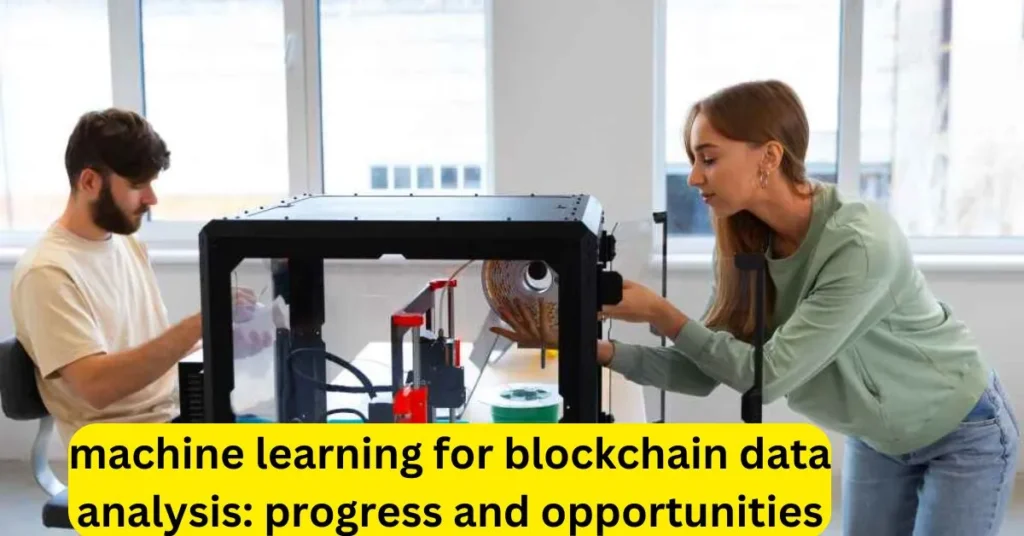
Introduction
Machine Learning for Blockchain Data Analysis: progress and possibilities are revolutionizing how we interpret blockchain networks. Blockchain generation has transformed numerous industries by providing decentralized, transparent, and immutable report-maintaining. However, as blockchain networks develop, studying the massive amounts of statistics they generate becomes increasingly more challenging. This is in which machine getting to know (ML) steps in, offering effective gear to extract treasured insights from blockchain data.
In this newsletter, we discover how device studying complements blockchain facts evaluation, its key packages, challenges, and destiny opportunities.
Machine Learning for Blockchain Data Analysis: Progress and Opportunities PDF
Blockchain networks produce massive-scale, complicated datasets, which are difficult to system manually. Machine learning can automate fact processing, recognize patterns, and expect traits, making it invaluable in blockchain analytics.
Consider the Bitcoin blockchain, which statistics hundreds of thousands of transactions daily. Identifying fraudulent sports in any such large dataset the use of traditional techniques is sort of not possible. However, ML algorithms can speedy analyze transaction styles and stumble on suspicious sports, enhancing security and efficiency.
To discover this subject matter similarly, you can download a PDF on system mastering for blockchain facts evaluation for in-intensity research insights.
Key Applications of Machine Learning for Blockchain Data Analysis
1. Fraud Detection and Security Enhancement
Blockchain’s transparency is a double-edged sword—it ensures responsibility but also exposes networks to fraud and cyberattacks. Machine learning knowledge can detect anomalies in transactions, assisting in saving you against scams like double spending, 51% assaults, and phishing.
Example:
A monetary institution the usage of blockchain-based transactions noticed increasingly more fraud attempts. By enforcing an ML-primarily based anomaly detection gadget, they efficiently identified and blocked fraudulent transactions in actual time, saving hundreds of thousands in ability losses.
2. Predictive Analytics for Cryptocurrency Markets
The cryptocurrency marketplace is notoriously volatile. Machine mastering fashions can analyze ancient charge developments and predict destiny price movements with excessive accuracy. Traders and investors use ML-based buying and selling bots to make informed selections, reducing risks and maximizing earnings.
three. Smart Contract Optimization
Smart contracts automate transactions at the blockchain. However, poorly optimized contracts can lead to inefficiencies and security vulnerabilities. Machine learning knowledge of algorithms can analyze and optimize clever contracts, ensuring higher overall performance and decreased vulnerabilities.
four. Blockchain Network Analysis
Analyzing blockchain networks manually is sort of not possible due to their complexity. Graph neural networks (GNNs) and different ML models assist in visualizing and recognizing blockchain interactions and identifying treasured insights on transaction styles and personal behaviors.
five. Compliance and Regulatory Support
Regulators regularly warfare to monitor blockchain transactions due to their decentralized nature. Machine learning knowledge can help in automating compliance checks, making sure groups comply with anti-cash laundering (AML), and recognizing your purchaser (KYC) guidelines efficaciously.
Machine Learning for Blockchain Data Analysis: Progress and Opportunities GitHub
For builders and researchers, GitHub repositories provide valuable sources on device studying for blockchain information analysis. Open-supply tasks help boost advancements in this domain.
You can explore relevant code and projects on GitHub’s blockchain ML repositories to benefit hands-on revel in and contribute to ongoing studies.
Challenges in Using Machine Learning for Blockchain Data Analysis
1. Data Privacy and Security Concerns
While blockchain offers transparency, ML-primarily based data analysis raises privacy issues. Handling sensitive consumer information calls for a balance between transparency and security.
2. Scalability Issues
Processing huge volumes of blockchain records calls for massive computing electricity. Federated learning and aspect computing answers can help mitigate these demanding situations.
three. Integration Complexities
Integrating ML models with blockchain networks remains a growing field. Overcoming compatibility troubles among ML algorithms and blockchain protocols is important for broader adoption.
Future Opportunities in Machine Learning and Blockchain
The intersection of machine getting to know and blockchain presents significant opportunities for innovation. Some emerging areas include:
- Decentralized AI Models: Using blockchain-based totally AI models ensures facts and privacy whilst permitting collaborative gaining knowledge of.
- Quantum Computing Integration: Advancements in quantum computing ought to revolutionize ML-driven blockchain analytics.
- Federated Learning: This technique permits secure, decentralized ML education throughout blockchain nodes.
Conclusion
The combination of device learning and blockchain is reshaping statistics analysis, security, and automation. As technology evolves, groups and researchers ought to include these improvements to stay ahead of the curve.
Would you like to explore ML-powered blockchain answers for your enterprise? Now is the time to harness the capability of this transformative technology!
For those looking to explore real-world applications of Machine Learning for Blockchain Data Analysis, platforms like iCryptoX.com Machine Learning offer valuable insights, tools, and resources to get started.


